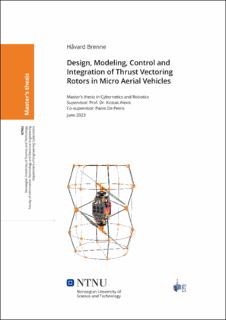| dc.description.abstract | Denne masteroppgaven omhandler modellering, regulering og implementering av en rotor der retningen på løftekraften kan styres med dreiemomentmodulering. Videre tar oppgaven for seg simulering, rotor design og styring, og integrering i små luftfartøy. Rotorkonseptet tillater styring av rotorens stilling og rotasjonshastighet ved hjelp av kun en enkelt aktuator. Denne styringen oppnås gjennom harmonisk motorstyring med en rotor som har strategisk plasserte passive hengsler. Dette kan være svært nyttig for å oppnå bedre effektivitet og manøvreringsegenskaper for luftfartøy.
En modell av denne rotoren er utviklet i denne oppgaven. Den tar hensyn til ulineær aerodynamikk og en nøyaktig modell av rotorens bevegelseslikninger. Dens evne til å forutsi retningen til løftekraften med harmonisk motorstyring demonstreres ved å sammenligne simuleringer med målinger av en fysisk implementering av rotoren. Gitt den prediktive nøyaktigheten, har modellen potensial for fremtidige fremskritt innen rotordesign og regulering.
En feltorientert motorstyringsmetode brukes for å regulere harmonisk modulering av motorens dreiemoment. Egenutviklet fastvare for motordriveren tillot høyfrekvent harmonisk regulering. En fordel ved å implementer harmonisk modulering på motordriveren er at oppdateringsfrekvensen til reguleringskommandoer kan settes uavhenging av ønsket oppdateringsfrekvens for harmonisk modulering, noe som kan være spesielt nyttig for små rotorer som opererer ved høye rotasjonshastigheter.
Den fysiske rotoren ble designet med geometri og materialer som er i stand til å oppnå store vinkler i styring av løftekraften. Det endelige designet ble maskinert i høytytende plast. Sammen med motorstyringsstrategien muliggjorde dette en demonstasjon av regulering av løftekraftretningen i opp til 30 grader i elevasjonsvinkel.
En forenklet modell egnet for kontrollallokasjon er utledet. Denne modellen brukes for å utvikle et rammeverk for ubegrenset kontrollallokering for et generelt luftfartøy med et vilkårlig antall rotorer med styrbar løftekraftretning. Dette rammeverket ble implementert i autopilotprogramvare, der rotoroppsettet kan konfigureres i et brukergrensesnitt.
Et luftfartøy med to rotorer med styrbar løftekraftretning ble designet for å demonstrere den styrbare rotoren under flyvning. Grunnleggende flyveegenskaper og høy effektivitet ble demonstrert med de implementerte systemene. Luftfartøyet og systemene for styrbar løftekraftretning utviklet i denne oppgaven kan derfor brukes til videre undersøkelser innenfor små luftfartøy. | |
| dc.description.abstract | This thesis covers the modeling, control and implementation of a torque modulated, thrust vectoring rotor, from simulation, to rotor design and control, to integration in micro aerial vehicles. The thrust vectoring rotor concept allows control of the thrust vector by tilting the tip path plane of the rotor, using only a single actuator. This control is achieved through an articulated rotor with passive hinges, which are exploited by harmonic motor torque modulation to control the tip path plane of the rotor.
The rotor model developed in this work accounts for non-linear aerodynamic effects as well as accurate dynamics of the rotor articulation. Its ability to predict thrust vectoring with harmonic motor control is demonstrated by comparing simulations to measurements from a physical implementation of the rotor. Given the predictive accuracy, the model has potential for future advancements in rotor design and control.
A field oriented motor control approach is used to implement a torque modulation control law in mechanical terms, compared to modulation in electrical terms in previous work. Implementing sinusoidal torque modulation on custom motor driver firmware allowed high rate harmonic modulation. A notable benefit here is a decoupling of the update rate neccesary for motor commands, and the control rate neccesary for the harmonic control. This facilitates slower update rates in motor commands, and could be especially useful for smaller rotors that operate at higher rotational speeds.
The physical rotor was designed with geometry and materials capable of large thrust vectoring angles. The final design, machined in high performance plastic, combined with the motor control strategy, enabled demonstration of thrust vector elevation angles up to 30 degrees, surpassing results of previous work.
A simplified model suitable for control allocation is derived. The simplified model is used to develop unconstrained control allocation for a general rotorcraft with an arbitrary number of thrust vectoring rotors. This framework has been successfully implemented in open-source autopilot software, where rotor arrangements can be configured in a user interface.
A coaxial rotorcraft with two thrust vectoring rotors was designed to demonstrate the thrust vectoring rotor in flight. Basic hovering, flight control and great efficiency were demonstrated with the implemented systems. As further flight experiments and control strategies should be explored, this rotorcraft and thrust vectoring system could serve as a platform for future investigation and applications of thrust vectoring rotors and fully-actuated micro aerial vehicles. | |
